#STS-20
Text
Cancelled Missions: NASA's October 1977 Space Shuttle Flight Itinerary
"Soon after President Richard Nixon gave his blessing to the Space Shuttle Program on January 5, 1972, NASA scheduled its first orbital flight for 1977, then for March 1978. By early 1975, the date had slipped to March 1979. Funding shortfalls were to blame, as were the daunting engineering challenges of developing the world's first reusable orbital spaceship based on 1970s technology. The schedule slip was actually worse than NASA let on: as early as January 32, 1975, an internal NASA document (marked 'sensitive') gave a '90% probability date' for the first Shuttle launch of December 1979.
In October 1977, Chester Lee, director of Space Transportation System (STS) Operations at NASA Headquarters, distributed the first edition of the STS Flight Assignment Baseline, a launch schedule and payload manifest for the first 16 operational Shuttle missions. The document was in keeping with NASA's stated philosophy that reusable Shuttle Orbiters would fly on-time and often, like a fleet of cargo airplanes. The STS Utilization and Operations Office at NASA's Johnson Space Center (JSC) in Houston had prepared the document, which was meant to be revised quarterly as new customers chose the Space Shuttle as their cheap and reliable ride to space.
The JSC planners assumed that six Orbital Flight Test (OFT) missions would precede the first operational Shuttle flight. The OFT flights would see two-man crews (Commander and Pilot) put Orbiter Vehicle 102 (OV-102) through its paces in low-Earth orbit. The planners did not include the OFT schedule in their document, but the May 30, 1980 launch date for their first operational Shuttle mission suggests that they based their flight schedule on the March 1979 first OFT launch date.
Thirteen of the 16 operational flights would use OV-102 and three would use OV-101. NASA would christen OV-102 Columbia in February 1979, shortly before it rolled out of the Rockwell International plant in Palmdale, California.
As for OV-101, its name was changed from Constitution to Enterprise in mid-1976 at the insistence of Star Trek fans. Enterprise flew in Approach and Landing Test (ALT) flights at Edwards Air Force Base in California beginning on February 15, 1977. ALT flights, which saw the Orbiter carried by and dropped from a modified 747, ended soon after the NASA JSC planners released their document.
The first operational Space Shuttle mission, Flight 7 (May 30 - June 3, 1980), would see Columbia climb to a 225-nautical-mile (n-mi) orbit inclined 28.5° relative to Earth's equator (unless otherwise stated, all orbits are inclined at 28.5°, the latitude of Kennedy Space Center in Florida). The delta-winged Orbiter would carry a three-person crew in its two-deck crew compartment and the bus-sized Long Duration Exposure Facility (LDEF) in its 15-foot-wide, 60-foot-long payload bay.
Columbia would also carry a 'payload of opportunity' - that is, an unspecified payload. The presence of a payload of opportunity meant that the flight had available excess payload weight capacity. Payload mass up would total 27,925 pounds. Payload mass down after the Remote Manipulator System (RMS) arm hoisted LDEF out of Columbia's payload bay and released it into orbit would total 9080 pounds.

A page from the STS Flight Assignment Baseline document of October 1977 shows payloads and other features of the first five operational Space Shuttle missions plus Flight 12/Flight 12 Alternate
During Flight 8 (July 1-3, 1980), Columbia would orbit 160 n mi above the Earth. Three astronauts would release two satellites and their solid-propellant rocket stages: Tracking and Data Relay Satellite-A (TDRS-A) with a two-stage Interim Upper Stage (IUS) and the Satellite Business Systems-A (SBS-A) commercial communications satellite on a Spinning Solid Upper Stage-Delta-class (SSUS-D).
Prior to release, the crew would spin the SBS-A satellite about its long axis on a turntable to create gyroscopic stability and raise TDRS-A on a tilt-table. After release, their respective solid-propellant stages would propel them to their assigned slots in geostationary orbit (GEO), 19,323 n mi above the equator. Payload mass up would total 51,243 pounds; mass down, 8912 pounds, most of which would comprise reusable restraint and deployment hardware for the satellites.
The TDRS system, which would include three operational satellites and an orbiting spare, was meant to trim costs and improve communications coverage by replacing most of the ground-based Manned Space Flight Network (MSFN). Previous U.S. piloted missions had relied on MSFN ground stations to relay communications to and from the Mission Control Center (MCC) in Houston. Because spacecraft in low-Earth orbit could remain in range of a given ground station for only a few minutes at a time, astronauts were frequently out of contact with the MCC.
On Flight 9 (August 1-6, 1980), Columbia would climb to a 160-n-mi orbit. Three astronauts would deploy GOES-D, a National Oceanic and Atmospheric Administration (NOAA) weather satellite, and Anik-C/1, a Canadian communications satellite. Before release, the crew would raise the NOAA satellite and its SSUS-Atlas-class (SSUS-A) rocket stage on the tilt-table and spin up the Anik-C/1-SSUS-D combination on the turntable. In addition to the two named satellites, NASA JSC planners reckoned that Columbia could carry a 14,000-pound payload of opportunity. Payload mass up would total 36,017 pounds; mass down, 21,116 pounds.
Following Flight 9, NASA would withdraw Columbia from service for 12 weeks to permit conversion from OFT configuration to operational configuration. The JSC planners explained that the conversion would be deferred until after Flight 9 to ensure an on-time first operational flight and to save time by combining it with Columbia's preparations for the first Spacelab mission on Flight 11. The switch from OFT to operational configuration would entail removal of Development Flight Instrumentation (sensors for monitoring Orbiter systems and performance); replacement of Commander and Pilot ejection seats on the crew compartment upper deck (the flight deck) with fixed seats; power system upgrades; and installation of an airlock on the crew compartment lower deck (the mid-deck).
Flight 10 (November 14-16, 1980) would be a near-copy of Flight 8. A three-person Columbia crew would deploy TDRS-B/IUS and SBS-B/SSUS-D into a 160-n-mi-high orbit. The rocket stages would then boost the satellites to GEO. Cargo mass up would total 53,744 pounds; mass down, 11,443 pounds.
Flight 11 (December 18-25, 1980) would see the orbital debut of Spacelab. Columbia would orbit Earth 160 n mi high at 57° of inclination. NASA and the multinational European Space Research Organization (ESRO) agreed in August 1973 that Europe should develop and manufacture Spacelab pressurized modules and unpressurized pallets for use in the Space Shuttle Program. Initially dubbed the 'sortie lab,' Spacelab would operate only in the Orbiter payload bay; it was not intended as an independent space station, though many hoped that it would help to demonstrate that an Earth-orbiting station could be useful.
ESRO merged with the European Launcher Development Organization in 1975 to form the European Space Agency (ESA). Columbia's five-person crew for Flight 11 would probably include scientists and at least one astronaut from an ESA member country.
Flight 12 (January 30 - February 1, 1981), a near-copy of Flights 8 and 10, would see Columbia's three-person crew deploy TDRS-C/IUS and Anik-C/2/SSUS-D into 160-n-mi-high orbit. Payload mass up would total 53,744 pounds; mass down, 11,443 pounds.
JSC planners inserted an optional 'Flight 12 Alternate' (January 30 - February 4, 1981) into their schedule which, if flown, would replace Flight 12. Columbia would orbit 160 n mi above the Earth. Its three-person crew would deploy Anik-C/2 on a SSUS-D stage. The mission's main purpose, however, would be to create a backup launch opportunity for an Intelsat V-class satellite already scheduled for launch on a U.S. Atlas-Centaur or European Ariane I rocket. An SSUS-A stage would boost the Intelsat V from Shuttle orbit to GEO.
NASA JSC assumed that, besides the satellites, stages, and their support hardware, Columbia would for Flight 12 Alternate tote an attached payload of opportunity that would need to operate in space for five days to provide useful data (hence the mission's planned duration). Payload mass up would total 37,067 pounds; mass down, 17,347 pounds.

Space Shuttle Flights 13 through 18 would include the first orbital mission of the OV-101 Enterprise (Flight 17), during which astronauts would retrieve the LDEF payload deployed during Flight 7.
Flight 13 (March 3-8, 1981) would see three astronauts on board Columbia release NOAA's GOES-E satellite attached to an SSUS-D stage into a 160-n-mi-high orbit. OV-102 would have room for two payloads of opportunity: one attached at the front of the payload bay and one deployed from a turntable aft of the GOES-E/SSUS-D combination. Payload mass up would total 38,549 pounds; mass down, 23,647 pounds.
Flight 14 would last 12 days, making it the longest described in the STS Flight Assignment Baseline document. Scheduled for launch on April 7, 1981, it would carry a 'train' of four unpressurized Spacelab experiment pallets and an 'Igloo,' a small pressurized compartment for pallet support equipment. The Igloo, though pressurized, would not be accessible to the five-person crew. OV-102 would orbit 225 n mi high at an inclination of 57°. Mass up would total 31,833 pounds; mass down, 28,450 pounds.
Flight 15 (May 13-15, 1981) would be a near-copy of Flights 8, 10, and 12. OV-102 would transport to orbit a payload totaling 53,744 pounds; payload mass down would total 11,443 pounds. The JSC planners noted the possibility that none of the potential payloads for Flight 15 — TDRS-D and SBS-C or Anik-C/3 — would need to be launched as early as May 1981. TDRS-D was meant as an orbiting spare; if the first three TDRS operated as planned, its launch could be postponed. Likewise, SBS-C and Anik-C/3 were each a backup for the previously launched satellites in their series.
Flight 16 (June 16-23, 1981) would be a five-person Spacelab pressurized module flight aboard OV-102 in 160-n-mi-high orbit. Payloads of opportunity totaling about 18,000 pounds might accompany the Spacelab module; for planning purposes, a satellite and SSUS-D on a turntable behind the module was assumed. Payload mass up would total 35,676 pounds; mass down, 27,995 pounds.
Flight 17, scheduled for July 16-20, 1981, would see the space debut of Enterprise and the retrieval of the LDEF released during Flight 7. OV-101 would climb to a roughly 200-n-mi-high orbit (LDEF's altitude after 13.5 months of orbital decay would determine the mission's precise altitude).
Before rendezvous with LDEF, Flight 17's three-man crew would release an Intelsat V/SSUS-A and a satellite payload of opportunity. After the satellites were sent on their way, the astronauts would pilot Enterprise to a rendezvous with LDEF, snare it with the RMS, and secure it in the payload bay. Mass up would total 26,564 pounds; mass down, 26,369 pounds.
For Flight 18 (July 29-August 5, 1981), Columbia would carry to a 160-n-mi-high orbit a Spacelab pallet dedicated to materials processing in the vacuum and microgravity of space. The three-person flight might also include the first acknowledged Department of Defense (DOD) payload of the Space Shuttle Program, a U.S. Air Force pallet designated STP-P80-1. JSC called the payload 'Planned' rather than 'Firm' and noted somewhat cryptically that it was the Teal Ruby experiment 'accommodated from OFT [Orbital Flight Test].'
The presence of the Earth-directed Teal Ruby sensor payload would account for Flight 18's planned 57° orbital inclination, which would take it over most of Earth's densely populated areas. Payload mass up might total 32,548 pounds; mass down, 23,827 pounds.

Space Shuttle Flights 20 through 23 would include the first mission to make use of an OMS kit to increase its orbital altitude (Flight 21), the first European Space Agency-sponsored Spacelab mission (Flight 22), and the launch of the Jupiter Orbiter and Probe spacecraft (Flight 23)
Flight 19 (September 2-9, 1981) would see five Spacelab experiment pallets fill Columbia's payload bay. Five astronauts would operate the experiments, which would emphasize physics and astronomy. The Orbiter would circle Earth in a 216-n-mi-high orbit. Payload mass up would total 29,214 pounds; mass down, 27,522 pounds.
Flight 20 (September 30-October 6, 1981), the second Enterprise mission, would see five astronauts conduct life science and astronomy experiments in a 216-n-mi-high orbit using a Spacelab pressurized module and an unpressurized pallet. JSC planners acknowledged that the mission's down payload mass (34,248 pounds) might be 'excessive,' but noted that their estimate was 'based on preliminary payload data.' Mass up would total 37,065 pounds.
On Flight 21, scheduled for launch on October 14, 1981, Columbia would carry the first Orbital Maneuvering System (OMS) Kit at the aft end of its payload bay. The OMS Kit would carry enough supplemental propellants for the Orbiter's twin rear-mounted OMS engines to perform a velocity change of 500 feet per second. This would enable OV-102 to rendezvous with and retrieve the Solar Maximum Mission (SMM) satellite in a 300-n-mi-high orbit.
Three astronauts would fly the five-day mission, which would attain the highest orbital altitude of any flight in the STS Flight Assignment Baseline document. JSC planners noted that the Multi-mission Modular Spacecraft (MMS) support hardware meant to carry SMM back to Earth could also transport an MMS-type satellite into orbit. Payload mass up would total 37,145 pounds; mass down, 23,433 pounds.
On Flight 22 (November 25 - December 2, 1981), Enterprise might carry an ESA-sponsored Spacelab mission with a five-person crew, a pressurized lab module, and a pallet to a 155-to-177-n-mi orbit inclined at 57°. Payload mass up might total 34,031 pounds; mass down, 32,339 pounds.
During Flight 23 (January 5-6, 1982), the last described in the STS Flight Assignment Baseline document, three astronauts would deploy into a 150-to-160-n-mi-high orbit the Jupiter Orbiter and Probe (JOP) spacecraft on a stack of three IUSs. President Jimmy Carter had requested new-start funds for JOP in his Fiscal Year 1978 NASA budget, which had taken effect on October 1, 1977. Because JOP was so new when they prepared their document, JSC planners declined to estimate up/down payload masses.
Flight 23 formed an anchor point for the Shuttle schedule because JOP had a launch window dictated by the movements of the planets. If the automated explorer did not leave for Jupiter between January 2 and 12, 1982, it would mean a 13-month delay while Earth and Jupiter moved into position for another launch attempt.
Almost nothing in the October 1977 STS Flight Assignment Baseline document occurred as planned. It was not even updated quarterly; no update had been issued as of mid-November 1978, by which time the target launch dates for the first Space Shuttle orbital mission and the first operational Shuttle flight had slipped officially to September 28, 1979 and February 27, 1981, respectively.
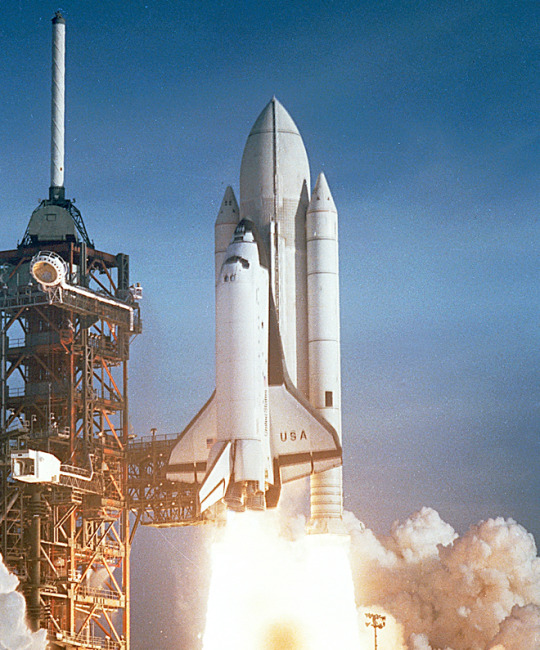
The Space Shuttle Orbiter Columbia lifts off at the start of STS-1.
The first Shuttle flight, designated STS-1, did not in fact lift off until April 12, 1981. As in the STS Flight Assignment Baseline document, OV-102 Columbia performed the OFT missions; OFT concluded, however, after only four flights. After the seven-day STS-4 mission (June 27 - July 4, 1982), President Ronald Reagan declared the Shuttle operational.
The first operational flight, also using Columbia, was STS-5 (November 11-16, 1982). The mission launched SBS-3 and Anik-C/3; because of Shuttle delays, the other SBS and Anik-C satellites planned for Shuttle launch had already reached space atop expendable rockets.
To the chagrin of many Star Trek fans, Enterprise never reached space. NASA decided that it would be less costly to convert Structural Test Article-099 into a flight-worthy Orbiter than to refit Enterprise for spaceflight after the ALT series. OV-099, christened Challenger, first reached space on mission STS-6 (April 4-9, 1983), which saw deployment of the first TDRS satellite.
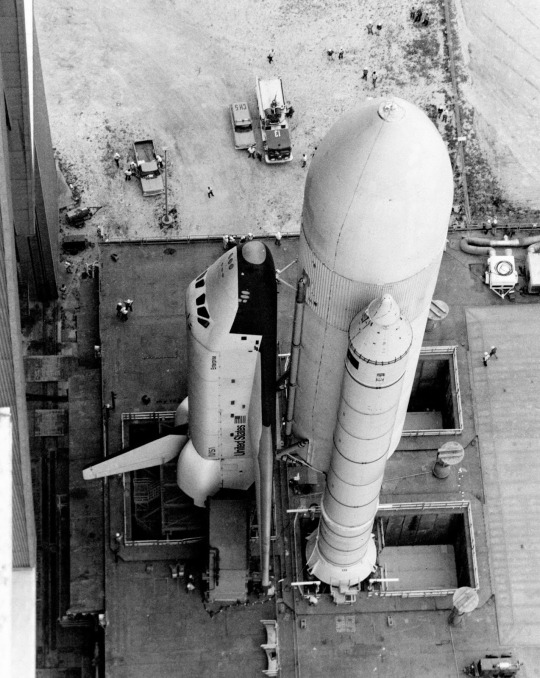
NASA put OV-101 Enterprise to work in a variety of tests and rehearsals (such as the 'fit check' shown in the image above), but did not convert it into a spaceflight-worthy Orbiter.
The voluminous Spacelab pressurized module first reached orbit on board Columbia on mission STS-9 (November 28- December 8,1983). The 10-day Spacelab 1 mission included ESA researcher Ulf Merbold and NASA scientist-astronauts Owen Garriott and Robert Parker. Garriott, selected to be an astronaut in 1965, had flown for 59 days on board the Skylab space station in 1973. Parker had been selected in 1967, but STS-9 was his first spaceflight.
The 21,500-pound LDEF reached Earth orbit on board Challenger on STS-41C, the 11th Space Shuttle mission (April 6-13, 1984). During the same mission, astronauts captured, repaired, and released the SMM satellite, which had reached orbit on 14 February 1980 and malfunctioned in January 1981. Challenger reached SMM without an OMS kit; in fact, no OMS kit ever reached space.
STS Flight Assignment Baseline document assumed that 22 Shuttle flights (six OFT and 16 operational) would occur before January 1982. In fact, the 22nd Shuttle flight did not begin until October 1985, when Challenger carried eight astronauts and the West German Spacelab D1 into space (STS-61A, October 30 - November 6, 1985). Three months later (28 January 1986), Challenger was destroyed at the start of STS-51L, the Shuttle Program's 25th mission.
In addition to seven astronauts — NASA's first in-flight fatalities — Challenger took with it TDRS-B, NASA's second TDRS satellite. The Shuttle would not fly again until September 1988 (STS-26, September 29 - October 3, 1988). On that mission, OV-103 Discovery deployed TDRS-C. The TDRS system would not include the three satellites necessary for global coverage until TDRS-D reached orbit on board Discovery on mission STS-29 (13-18 March 1989).
Following the Challenger accident, NASA abandoned — though not without some resistance — the pretense that it operated a fleet of cargo planes. The space agency had at one time aimed for 60 Shuttle flights per year; between 1988 and 2003, the Shuttle Program managed about six per year. The most flights the Shuttle fleet accomplished in a year was nine in 1985.
Shuttle delays meant that JOP, renamed Galileo, missed its early January 1982 launch window. It was eventually rescheduled for May 1986, but the Challenger accident intervened. Galileo finally left Earth orbit on 18 October 1989 following deployment from OV-104 Atlantis during STS-34 (October 18-23, 1989).
Between the time JOP/Galileo received its first funding and the Challenger explosion, NASA, the White House, and Congress had sparred over how the Jupiter spacecraft would depart Earth orbit. Eventually, they settled on the powerful liquid-propellant Centaur-G' rocket stage.
Citing new concern for safety following Challenger, NASA canceled Centaur G'. Galileo had to rely on the less-powerful IUS, which meant that it could not travel directly to Jupiter; it had instead to perform gravity-assist flybys of Venus and Earth to reach its exploration target. Galileo did not reach the Jupiter system until December 1995.
LDEF had been scheduled for retrieval in March 1985, less than a year after deployment, but flight delays and the Challenger accident postponed its return to Earth by nearly six years. On mission STS-32 (January 9-20, 1990), astronauts on board Columbia retrieved LDEF, the orbit of which had decayed to 178 n mi. LDEF remains the largest object ever retrieved in space and returned to Earth.
During reentry at the end of mission STS-107 (16 January-1 February 2003), Columbia broke apart over northeast Texas, killing its international crew of seven astronauts. This precipitated cancellation of the Space Shuttle Program by President George W. Bush, who announced his decision on 14 January 2004.
The end of the Space Shuttle Program was originally scheduled for 2010, immediately following the planned completion of the International Space Station. In the event, STS-135, the final Space Shuttle mission, took place four years ago (July 2011), three months after the 30th anniversary of STS-1. The Orbiter Atlantis lifted off on 8 July with a four-person crew — the smallest since STS-6. It docked with the International Space Station to deliver supplies and spares and landed in Florida 13 days later."
Article by David S. F. Portree: link
source, source
NASA ID: S77-5784, S77-5785, S77-5758
#STS-1#STS-2#STS-3#STS-4#STS-5#STS-6#STS-7#STS-8#STS-9#STS-10#STS-11#STS-12#STS-13#STS-14#STS-15#STS-16#STS-17#STS-18#STS-19#STS-20#STS-21#STS-22#STS-23#Space Shuttle Columbia#Columbia#OV-102#Space Shuttle Enterprise#Enterprise#OV-101#cancelled
29 notes
·
View notes
Text







Back in August, my mother, my sister and I did a three day roadtrip to Lake Placid in New York State, where the 1932 and 1980 Winter Olympics were hosted. We hiked and visited Adirondack natural wonders the two first days, but because my health was starting to fail me on the second day, we kept the third one for visiting the Downton Abbey costume exhibition at the Lake Placid Center for the arts.
On our way to the exhibit, we passed by the Pines Inn, formerly known as the St. Moritz Hotel, a hotel built in 1907. I had wanted to stay at that hotel, but my mom refused, saying it was in poor shape and looked haunted on the hotel booking sites (she wasn't wrong, but I love that stuff, as you know). I still insisted for us to at least visit it, and we sure did NOT regret it. We stumbled upon one of the concierges (or new owners, correct me if you see this!), and he loved my outfit so much that he gave us a tour of the hotel, including in areas closed to guests. He told us that Albert Einstein and the Kennedys had been guests at the hotel, that there was n*de sunbathing on the roof in the 1930s and that a lot of the furniture was original. Sadly, after the 80s, the hotel slowly went into decrepitude and abandonment, and many things got stolen and damaged. The new owners are currently working hard to restore the hotel, and it's indeed a lot of work.
Outfit rundown
Dress: vintage Ingeborg (Pink House)
Velvet michiyuki: vintage
Hat: Rudsak with added brooch by Fuwari
Gloves: vintage
Shoes: old Clarks
Bag: second-hand Vivienne Westwood
Belt: thrifted
Big British stamp brooch: second-hand Jane Marple
Small marine cat stamp brooch: Via Carousel
Anchor and crest brooches: vintage
Earrings: old Dracolite
#fashion#vintage#vintage style#vintage fashion#1920's#1920's fashion#1920 fashion#20's fashion#retro fashion#pink house#jfashion#historybounding#old buildings#historical building#old hotel#lake placid#st. moritz#1900s architecture#antique#antique decor#long hairstyles#vintage hair#faux bob#vintage makeup#fanny rosie#fannyrosie
485 notes
·
View notes
Text

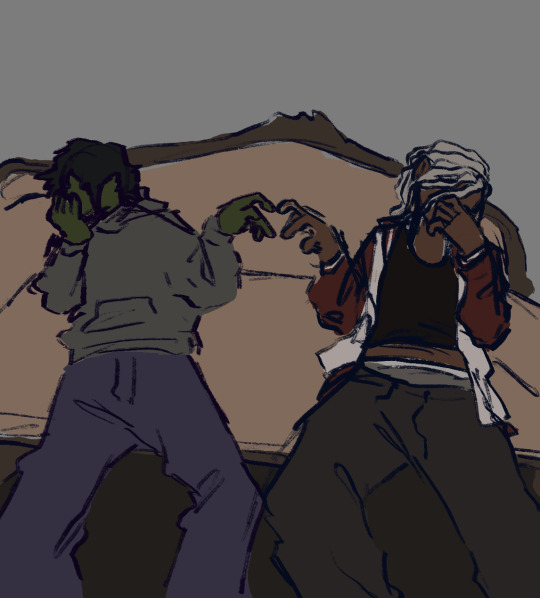



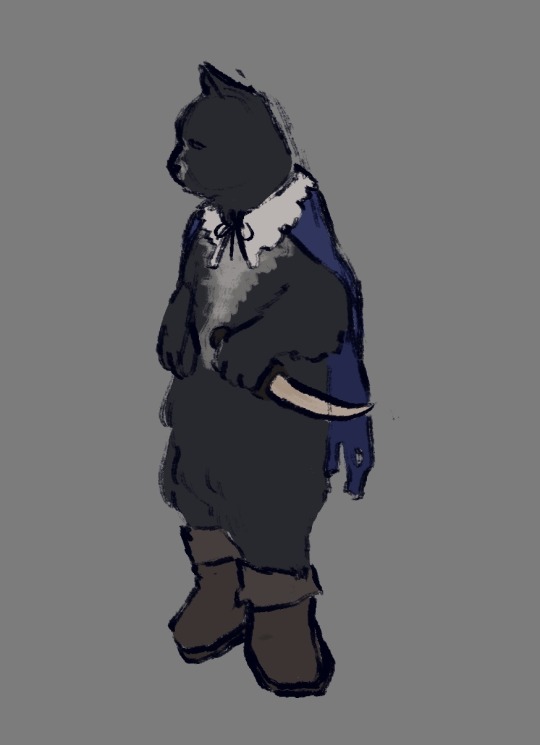


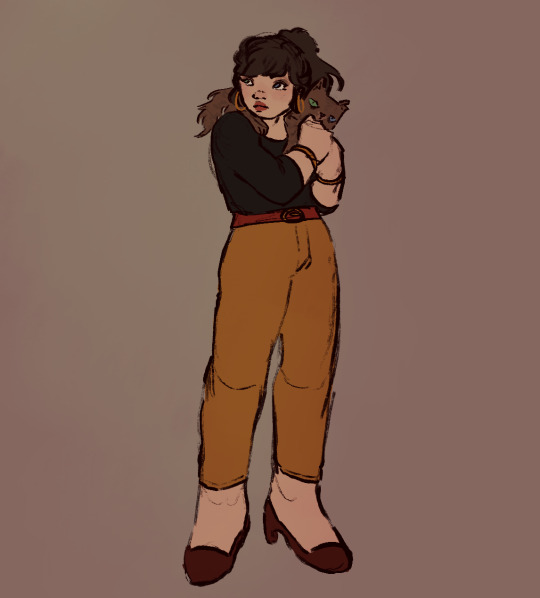
[start i.d.: nine colored sketch drawings of various dimension 20 characters. the first is fig playing her bass, her hair shaggy in her eyes. the second is gorgug and fabian slouched on a couch, looking away from each other but forming a hand heart together. the next four are individuals of baron, markus st. vincent, adaine, and pib. the seventh is kristen and tracker spooning. the eighth is fig and ayda standing so close their noses touch. the last is of sofia with la gran gata around her shoulders. end i.d.]
a bunch of doodle requests from twitter. hi
#ur invited to make reqs here just no promises i’ll get to them#sorry for the very brief id but it is honestly equivalent to the visual quality of these so eh#fantasy high#dimension 20#fhsy#ok now to tag characters HHH#fig faeth#gorgug thistlespring#fabian seacaster#baron from the baronies#markus st vincent#adaine abernant#pib neverafter#kristen applebees#tracker o'shaughnessey#ayda aguefort#sofia lee#my art#digital art#simply for. sorting purposes
1K notes
·
View notes
Text
if i can be corny for a second i wanna talk about the greatest strengths of the 2003 tmnt series and why it speaks to me (esp as a queer person)
so i might have alluded to this before, but let me say it outright: each show is definitely a product of its time, and the ideals of whatever generation its from. whether talking about the humour, the story, the dialogue etc, its always important to remember that these shows will always come off in a way due to the generation theyre from. and thats not a bad thing! it just means its important to think about them from that perspective.
2003 is a show of my generation growing up, and a thing about that era that maybe some people younger than me wont understand is there is so much more language commonly available to describe yourself now than there was then. you can take this in any context; mental health, sexuality, gender identity, or even just the ability to describe your relationships with more (idk if this will be the right word) therapist language.
in 03 we have a family unit of splinter and his sons, each with their own strengths and weaknesses. we have a splinter who hasnt opened up to his sons about the trauma hes experienced, but not in a way of shutting them out, simply because it isnt their responsibility to know as they are teenagers. he tells them of the mutagen that created them, but not of his past with his master yoshi, who he calls father when by himself, but never around his sons which is just an interesting concept to think about.
(i do not intent this next sentence as ragging on the two shows after this when i say it, simply from a character standpoint) this is the splinter who completely doesnt make his problems his sons problems, but he also is very willing to tell them the truth when he knows they're ready. this is is the most idyllic version of splitner out of all of them, even when comparing to his mirage counterpart (who hes the most based on) due to that splinter raising them to be ninja specifically to make them fight shredder. this one is just their father who loves them and wants to keep them safe the best way he can, and he was never a human in the first place to even know how to be that. so this whole family dynamic starts with him, and the way he raised his sons reflects his parenting.
so, the setting and year this show is made is 2003. something very relatable here is how there isnt a lot of language for the personality quirks of the turtles. there's so much evidence here for mikey having adhd, his brothers will say things like "why doesnt mikey have to help?" and the answer is "well, he'd be bored. and whats worse, mikey not helping or mikey being bored?" its this beautiful moment of, "hey, we know its not fair, but thats how mikey is, and its better for everyone if we just respect that thats how he is" mikey cant keep his hands off stuff, they know this they dont yell at him for behaving that way, they just stop him. this coding feels the most specific, but like i said. its 2003. we dont have the words to describe what this is yet, and if we do its not common knowledge.
another example is in the classic episode where raphael meets casey jones. raphael is sparring with mikey, and he lashes out and nearly kills mikey. everyone reacts to this by getting him to stop, and no one is more upset than raphael himself. they all tell him to go get some air, which he does. theres no moment of any of them screaming at him for losing his temper, its very clear that they all know he's going to do that himself. and he does go get some air. they all know thats what he needs. he goes and meets casey jones, another hot head, and raph has to help coach this hot head on his anger. when he comes back at the end of the episode after having let out that aggression, he apologizes and no one is upset with him. there's a very clear understanding among his family that he cannot help it, but the best thing they can do is give him his space when he needs it. watching this from a 2023 perspective (20 years later) im sure we could analyze this as a few things going on with raph, my mind comes to autism but at the end of the day it doesnt matter why he behaves like this, the point is that he does and the best thing his family does is just...help him. which they do. and they never hold it against him.
when leo is going through his ptsd arc hes at his closest to raph as a character, the show draws a lot of parallels (like having him go let out some aggression with casey) and we get to see the dynamic in reverse. in "i, monster" (the rat king episode) leo is losing it, taking on rat king alone and not wanting to let up. raphael is actively holding his brothers back when they say "we shouldnt leave him to fight alone", raphael says "if leo gets in trouble i'm the first one in there, but right now it looks like leo's got more than one monster to work out of his system" raph doesn't exactly know what leos going through, but he recognizes it. he knows he needs to fight alone, so raph lets him. its only when the building collapses and leo is no longer in a safe position that he says "leo lets go", which leo wordlessly agrees with and actually listens.
this is what i think is the best part of these guys, the unconditional understanding they have for the way they are. we still have our "raphs a big hot head" "mikeys annoying" jokes, but they feel like genuine good natured sibling ribbing because they know each other on that level.
and to go back to the fact that this show is set in 2003, there's something so specific about the way mikey constantly makes references to liking women's clothing, to being fine with feminine language, and to being open about being the pretty turtle who "has that effect on minds of men" speaks to me as a queer person. this could easily be intended as homophobic jokes and probably is, because again.... its the mid 2000s, thats very much what media was like, thats what the jokes were. especially with the girly screams mikey does being one of the first jokes of this nature.
but theres something that happens in season 4, where an alien is attacking mikey, and donnie rushes in and says "hey, thats my sibling" that sticks out. and it happens again in fast forward. when talking to the dark turtles leo says "you and your brothers" "me and my siblings"
because of the way this family unit just understands each other without ever having a conversation about things, it feels like its not a joke. theres some kind of affirmation happening here. even if it seems like i could be reading into it too much, its specific! and it keeps happening!
and by the end of the show, when mikey says he wants to be maid of honour, even if that line in the media itself was intended to be a joke, no one in their family treats it like one. of course mikey is the maid of honour, he asked to be one! the only real offence taken is when april says bride's maid, to which he is offended because hes so much more important than that!
so from a story standpoint, this show doesnt have the intricate complexities and butting heads of latter iterations, there isnt much relationship growth to be had (in fact once we get to around season 5 the flanderization of the characters kind of begins and it loses some of the more complexities) but thats because its just not the focus of the story! the story is more about what they go through together, and thats fine! thats what our shows kind of were at the time. not saying there isnt any relationship growth, but its very much not the focus because these turtles? they already understand each other in a healthy way.
so to me, these guys are kind of the most wholesome family unit
#tmnt#tmnt 03#tmnt 2k3#tmnt 2003#2003 tmnt#can you tell im in my late 20s#lmao#this is why i did the silly st thing#cuz its relatable#thoughts
875 notes
·
View notes
Text

Tuvok Voice: You are her official right hand while I have been making detailed psychological observations about her for the past four years - we are not the same.

[Patreon | Ko-fi]
#love early seasons Tuvok where he really goes hard on hissing at Chakotay like '/I/ know her best. She trusts /ME/ the most'#wish they had a whole episode about the three of them and their dynamic. REAAAALLY I wish there was a whole multi-episode arc about it#Tuvok#Kathryn Janeway#I didn't wanna draw any particular uniform bc I don't really care when precisely they were ensigns#and the show doesn't either (Janeway has known Tuvok 6 or 20 years)#the starfleet uniform changes so much anyway <3 I don't mind - it's fun#st voyager#voy#st voy#star trek voyager#this can be ship art if you believe#bea art tag#there is SOMETHING going on between them#Tuvok has a file somewhere that's just FOUR + /YEARS/ of observations on Janeway#I need you to understand - at the time of him saying this they have not been in the delta quadrant for four years. He was doing this BEFORE
113 notes
·
View notes
Photo


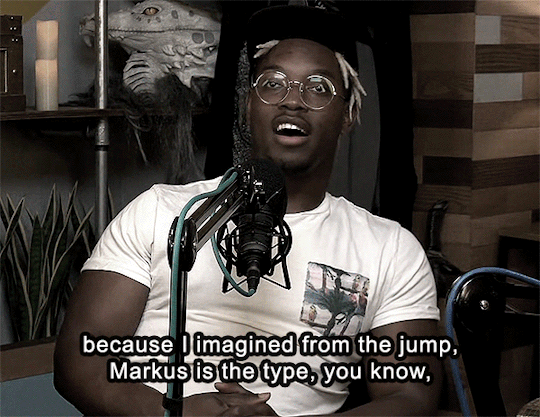




#escape from the bloodkeep#dimension 20#skullkisses#markus st vincent#leiland#kraz-thun#i just was thinking about them again and wanted to make a gifset#and also lament that ify didn't have time to do whatever he was thinking of doing with leiland
3K notes
·
View notes
Text

i hate drawing armor so i decided for forgo clothes all together
#like whats the point of having a brand new corporeal form if youre gonna wear bulky armor#dimension 20#escape from the bloodkeep#leiland#markus st vincent#znoze
98 notes
·
View notes
Text
Something funny I just noticed rewatching Fantasy High Junior Year is that the Paladin Teacher, Halo St Croix, cast Counterspell. I didn't catch it the first time cuz it was a quick thing for a bit, but that isn't a spell that Paladins get normally. They can, however, get it from a Paladin oath. Specifically, Oath of Redemption and Oath of the Watchers. And since Halos didn't seem confrontational towards Fig after learning she's an archdevil, they must be Oath of Redemption
#dimension 20#fantasy high#fhjy#Halo St Croix#I am a paladin main and I want to know more about this man (nonbinary)
67 notes
·
View notes
Text
I’ve decided forever that Gertie Bladeshield is mtf Ava there will never be a point in time in which you can convince me otherwise
#d20 fantasy high#d20#fhjy#d20 fhjy#brennan lee mulligan#ally beardsley#dnd#fantasy high#dimension 20#fantasy high junior year#gertie bladeshield#kristen x gertie#beesbees#kristen chilis applebees#st kristen applebees#kristen applebees#mtf#trans#fantasy high headcanons
70 notes
·
View notes
Text
Bad Kids + Sharing Clothes Headcannons
Gorgug
It’s hard for him to share clothes because he’s bigger than everyone else, but luckily a lot of his friends have oversized clothes!!!
He’s sort of like Adaine in that he doesn’t go out of his way to steal things
But he does have a few things that have been left behind at the Thistlespring tree or that he’s borrowed
Tbh he probably has the most from Fig???
Like she’s big on the oversized t-shirt
And they were on tour together for so long
Who knows who those shirts originally belonged to??
He shows up to Mordred Manor one day and Sandra Lynn is like “that’s fig’s shirt? And Gorgug is like “oh are you sure??? I’ve had it for a while” and Sandra Lynn is just like “yeah i know because I bought it”
He goes to take it off immediately to return it but she waves him off and says that if Fig wants it back she’ll say something
Fig comes down the stairs and is like “cool shirt where’d you get it???”
Has some stuff from Kristen too
Mostly her cute little camp bracelets & stuff
But it’s always because she’ll go to do something weird and take them off like “here hold this for a minute it’s in the way”
Then he puts it on for safekeeping and she never asks for it back
TBH I feel like he has more little trinkets and things from his friends because I feel like they all kinda do that with him?
Like he always has (non-magical) pockets so he gets to hold earbuds, pens, folded up assignment papers, anything that is in the way at any given moment is passed along until it ends up in his hands and then his hoodie pocket
Then at the end of the day he just kind of empties his pockets and puts it on his dresser
Then everyone comes over as they realize they’re missing things to collect them and the cycle starts anew
He enjoys being the keeper of things, it makes him feel trusted and relied on
Some of Fabian’s athletic tanks
Adaine | Fig | Fabian | Kristen | Gorgug | Riz
#dimension 20#d20#fantasy high#dimension 20 spoilers#d20 fantasy high#kristen applebees#fhjy spoilers#moss speaks#riz gukgak#the bad kids#fabian aramais seacaster#figeroth faeth#fabian seacaster#fig faeth#fig fantasy high#gorgug fantasy high#gorgug thistlespring#st kristen applebees#adaine o'shaughnessey#adaine fantasy high#fabian fantasy high#riz fantasy high#kristen fantasy high#fig the infaethable
119 notes
·
View notes
Text

“Photographic documentation showing the LEASAT-3 satellite being repaired during Extravehicular Activity (EVA). Mission Specialist (MS) William F. Fisher (EVA-2) in an Extravehicular Mobility Unit (EMU) grasps the holding bar on the captured satellite, while standing on the starboard rim of the payload bay.”
Date: August 31, 1985
NARA: 22776996
#STS-51-I#STS-51I#STS-20#Space Shuttle#Space Shuttle Discovery#Discovery#OV-103#Orbiter#NASA#Space Shuttle Program#space#earth#satellite#August#1985#my post
32 notes
·
View notes
Text

If you were to travel back in time 89 years, this is what you would see today at Fifth Avenue & 42nd Street. April 20, 1935.
Photo: Associated Press
#vintage New York#1930s#42nd St.#5th Ave.#Fifth Ave.#Fifth Ave. & 42nd St.#April 20#20 April#street scene#trolley#double-decker bus#vintage Manhattan
64 notes
·
View notes
Note
soft dom stevie punishing you with fake sympathy and little shh’s
he loves it. watching his poor girl crumble underneath him. begging him and whining while he fucks you. one of his hands lifting your hips off the bed while the other squeezes the sides of your neck. fucking you till youre about to cum after being edged four times before. not even able to ask him like you usually would because hes fucked you so dumb, before pulling away right before you can orgasm. stroking your damp hair away from your face, radiating sweat and desire while you whine and chant his name.
“shhh, i know baby. poor thing, so wet for me. youre so beautiful. love it when youre fucked dumb like this. shhh, its okay, im gonna take care of you baby. sweet thing.” he coos, before kissing your lips and then your forehead.
and then he starts fucking you harder, faster and with intent. youre whining and moaning so much hes sure his neighbors could hear if they stepped outside. kissing you so softly and sweetly while he pounds into you. moving down to take your right nipple into his mouth while he rolls the left between his thumb and index finger. repeating the motion with the other. lifting your legs over his shoulders and finally bringing his hand to his mouth, coating his fingers with spit to add to your already wet clit. rubbing steady circles into it.
“fuck, i cant wait anymore. you want to cum sweetheart? yeah? what a good girl, baby. been so good to me. poor thing just needed to get fucked, huh? got to get my sweet, happy girl back. cmon, cum with me. let me fill up this pretty cunt, sweetheart.”
as soon as you felt his hot cum inside you, the wall broke. his name left your lips and youre screaming in ecstasy. sweet voice filling the room, making his head feel fuzzy. fucking his cum into you. cum spurting out of his pretty cock for a good 20 seconds until hes shaking above you, panting and red faced. falling down next to you and pulling you into his chest while you pant and kiss each-other all over.
“good job baby. god. im so lucky. cmon baby, lets go run you a bath.”
#wrote this in 20 minutes#dont look at me#was not proofread#at ALL#im sorry#steve harrington#steve harrington x reader#steve harrington x you#steve harrington smut#steve stranger things#stranger things#steve x you#st smut#steve x reader#steve harrington fluff#dove and steve
764 notes
·
View notes
Text
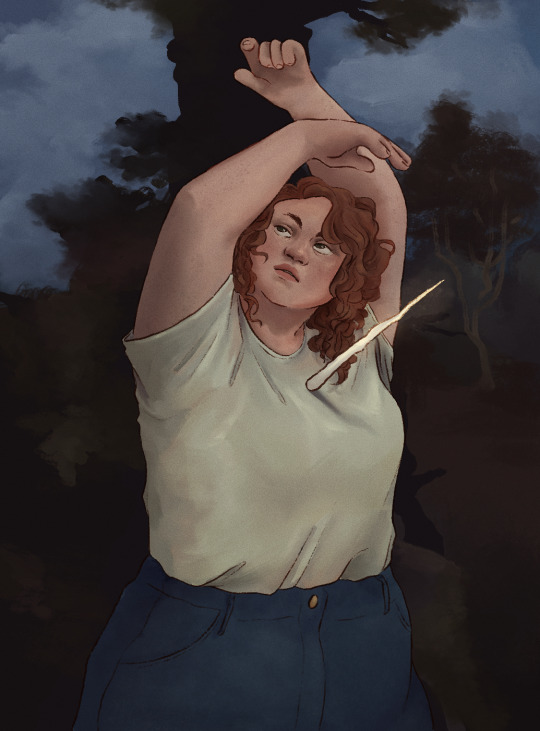
[start i.d.: a drawing of kristen applebees in homage to paintings of saint sebastian. she leans against a tree, arms above her head, as a white unicorn horn sticks out from her chest. she looks upward, merely disappointed. end i.d.]
god loves you but not enough to save you
#specifically the st sebastian painted by guido reni#kristen applebees#fantasy high#fantasy high spoilers#fhsy#dimension 20#the guido reni one because it’s the gayest one.#also recommend listening to sun bleached flies n thinking about kristen. if it’s meant to be then it will be. :[#my art#digital art
1K notes
·
View notes
Text

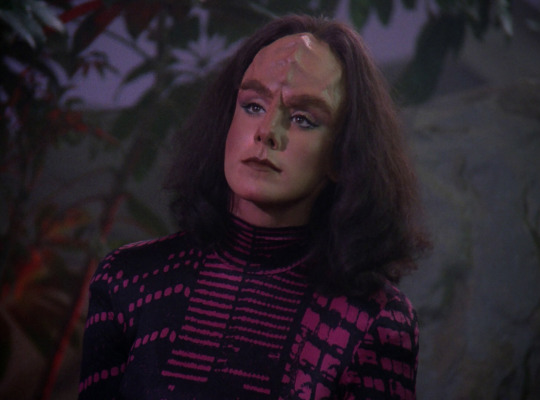


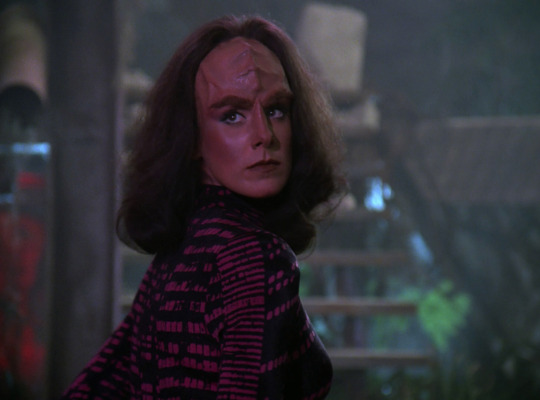

s t a r t r e k t h e n e x t g e n e r a t i o n created by gene roddenberry K'Ehleyr [the emissary, s2ep20]
#star trek#star trek the next generation#the next generation#gene roddenberry#star trek characters#tng character#K'Ehleyr#Suzie Plakson#tng season 2#the next generation season 2#tng the emissary#the emissary#lot: st tng season 2 ep 20/22 (ep 46/178)
148 notes
·
View notes
Text
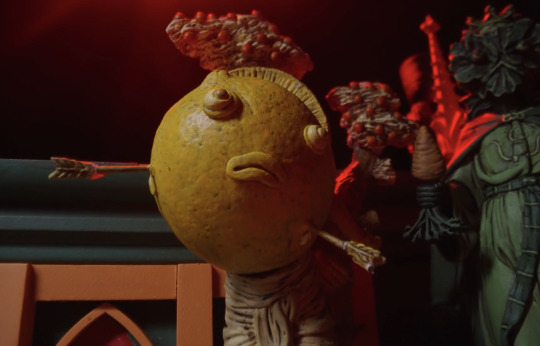

Obsessed with the St. Sebastian citrus saint on the The Ravening War set. The face, the pose, the arrows, the lemon slice halo.
376 notes
·
View notes